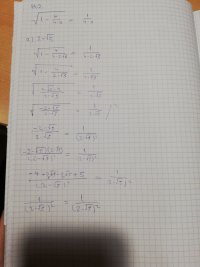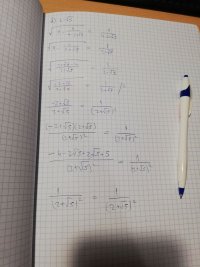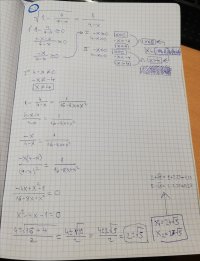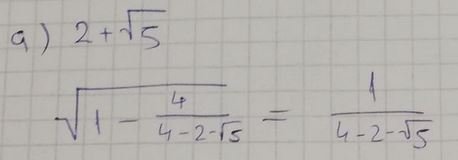You are using an out of date browser. It may not display this or other websites correctly.
You should upgrade or use an alternative browser.
You should upgrade or use an alternative browser.
How did the solution exclude one possibility?
- Thread starter Loki123
- Start date
Harry_the_cat
Elite Member
- Joined
- Mar 16, 2016
- Messages
- 3,779
By definition, the squareroot of anything is non-negative. ie >=0. So the RHS must be non-negative, ie x <= 4.
2 + sqrt(5) > 4, so if you If you sub 2 + sqrt(5) into the RHS, the RHS will be negative.
2 + sqrt(5) > 4, so if you If you sub 2 + sqrt(5) into the RHS, the RHS will be negative.
Steven G
Elite Member
- Joined
- Dec 30, 2014
- Messages
- 14,603
I would NOT find the domain. If you insist on doing it that way, then as Harry-the-cat pointed out you must also include in your domain that the right hand side must be positive. That is that 4-x > 0 or that x<4.
In this problem, I would simply solve the problem and then check my answer to see if any are erroneous.
Also stop using a calculator to see what 2+ sqrt(5) lies between.
We know that 2=sqrt(4) < sqrt(5) < sqrt(9) = 3. So sqrt(5) lies between 2 and 3. Hence 4 = 2+2 < 2 + sqrt(5) < 2+3 = 5. So yes, sqrt(5)>4!
In this problem, I would simply solve the problem and then check my answer to see if any are erroneous.
Also stop using a calculator to see what 2+ sqrt(5) lies between.
We know that 2=sqrt(4) < sqrt(5) < sqrt(9) = 3. So sqrt(5) lies between 2 and 3. Hence 4 = 2+2 < 2 + sqrt(5) < 2+3 = 5. So yes, sqrt(5)>4!
What is RHS?By definition, the squareroot of anything is non-negative. ie >=0. So the RHS must be non-negative, ie x <= 4.
2 + sqrt(5) > 4, so if you If you sub 2 + sqrt(5) into the RHS, the RHS will be negative.
We were taught to find the domain which is why I am trying to do it that way. I tried to just check the answers, but they both ended up working. Here is my work on that:I would NOT find the domain. If you insist on doing it that way, then as Harry-the-cat pointed out you must also include in your domain that the right hand side must be positive. That is that 4-x > 0 or that x<4.
In this problem, I would simply solve the problem and then check my answer to see if any are erroneous.
Also stop using a calculator to see what 2+ sqrt(5) lies between.
We know that 2=sqrt(4) < sqrt(5) < sqrt(9) = 3. So sqrt(5) lies between 2 and 3. Hence 4 = 2+2 < 2 + sqrt(5) < 2+3 = 5. So yes, sqrt(5)>4!


I know I should have rationalized them and, therefore, eliminated the square roots from the denominator, but I pretty sure that doesn't change anything. I probably went somewhere wrong, however, I checked it multiple times and couldn't find out where.
D
Deleted member 4993
Guest
RHS = Right Hand SideWhat is RHS?
Otis
Elite Member
- Joined
- Apr 22, 2015
- Messages
- 4,589
I am going to follow what you were told to do.
[math]\sqrt{1 - \dfrac{4}{4 - x}} = \dfrac{4}{4 - x}.[/math]
Obviously, if 4 - x is a denominator, then x cannot equal 4. Moreover, if x is greater than 4, then the right hand side of the equation is negative, but a square root is necessarily non-negative. Therefore, x must be less than 4.
[math]\sqrt{1 - \dfrac{4}{4 - x}} = \dfrac{4}{4 - x} \implies 1 - \dfrac{4}{4 - x} = \dfrac{16}{(4 - x)^2} \implies (4 - x)^2 - 4(4 - x) = 16 \implies \\ 16 - 8x + x^2 - 16 + 4x = 16 \implies x^2 - 4x - 16 = 0 \implies x = \dfrac{4 \pm \sqrt{(-4)^2 - 4(1)(-16)}}{2 * 1} \implies \\ x= \dfrac{4 \pm {16 + 64}}{2} = \dfrac{4 \pm {80}}{2} = \dfrac{4 \pm 2\sqrt {5}}{2} = 2 \pm \sqrt{5}.[/math]
This is what you got. But you
However, we previously determined that x < 4. And obviously
[math]4 < 5 \implies 2 \le \sqrt{5} \implies 2 + \sqrt{5} > 4 \implies x \ne 2 + \sqrt{5}.[/math]
Therefore that answer is not relevant based on the domain restriction. Our brilliant resident feline explained that way back in post 2.
[math]\sqrt{1 - \dfrac{4}{4 - x}} = \dfrac{4}{4 - x}.[/math]
Obviously, if 4 - x is a denominator, then x cannot equal 4. Moreover, if x is greater than 4, then the right hand side of the equation is negative, but a square root is necessarily non-negative. Therefore, x must be less than 4.
[math]\sqrt{1 - \dfrac{4}{4 - x}} = \dfrac{4}{4 - x} \implies 1 - \dfrac{4}{4 - x} = \dfrac{16}{(4 - x)^2} \implies (4 - x)^2 - 4(4 - x) = 16 \implies \\ 16 - 8x + x^2 - 16 + 4x = 16 \implies x^2 - 4x - 16 = 0 \implies x = \dfrac{4 \pm \sqrt{(-4)^2 - 4(1)(-16)}}{2 * 1} \implies \\ x= \dfrac{4 \pm {16 + 64}}{2} = \dfrac{4 \pm {80}}{2} = \dfrac{4 \pm 2\sqrt {5}}{2} = 2 \pm \sqrt{5}.[/math]
This is what you got. But you
However, we previously determined that x < 4. And obviously
[math]4 < 5 \implies 2 \le \sqrt{5} \implies 2 + \sqrt{5} > 4 \implies x \ne 2 + \sqrt{5}.[/math]
Therefore that answer is not relevant based on the domain restriction. Our brilliant resident feline explained that way back in post 2.
Steven G
Elite Member
- Joined
- Dec 30, 2014
- Messages
- 14,603
RHS means right hand side.What is RHS?
Steven G
Elite Member
- Joined
- Dec 30, 2014
- Messages
- 14,603
When you are checking the solution you want to verify that the left hand side really does equal 1/(2-sqrt(5)). You should not square both sides as that is what causes trouble.
For example if you have x=2, then x^2 = 4 so x = +/- 2. But that is absurd as you were told x=2!
Also, since you are are checking to see if the left hand side equals the right hand you should NOT use equal signs! Equals signs are used when you know that what is on side of the equal sign equals what is on the other side of the equal sign. The reason that you squared bot sides is because you felt that both sides are equal. You should put a question mark over the equal sign.
For example if you have x=2, then x^2 = 4 so x = +/- 2. But that is absurd as you were told x=2!
Also, since you are are checking to see if the left hand side equals the right hand you should NOT use equal signs! Equals signs are used when you know that what is on side of the equal sign equals what is on the other side of the equal sign. The reason that you squared bot sides is because you felt that both sides are equal. You should put a question mark over the equal sign.
Maybe he thought this was “Different Equations”?
I am taking mathematics... The education system is different around the world, please keep that in mind.
topsquark
Senior Member
- Joined
- Aug 27, 2012
- Messages
- 2,363
Please understand that I'm no longer getting on your case but is your class actually named "Mathematics?" What is the exact name of the class?I am taking mathematics... The education system is different around the world, please keep that in mind.
-Dan
Mathematics. But we call it just math.Please understand that I'm no longer getting on your case but is your class actually named "Mathematics?" What is the exact name of the class?
-Dan
To be honest, I don't like how the education system is where I am, I think multiple classes on different subjects relating to mathematics would have been better, but I can't really do anything about it other than learn.
HallsofIvy
Elite Member
- Joined
- Jan 27, 2012
- Messages
- 7,760
"Mathematics" includess a huge number of subdivisions:
arithmetic
algebra
geometry
trigonometry
pre-calculus
calculus
advanced algebra
differential equations
differential geometry
and more.
We were hoping for a more specific label than just "mathematics" so we could better see exactly what it is you are trying to do.
arithmetic
algebra
geometry
trigonometry
pre-calculus
calculus
advanced algebra
differential equations
differential geometry
and more.
We were hoping for a more specific label than just "mathematics" so we could better see exactly what it is you are trying to do.
I was trying to see if it's true by simplifying it... I got the same result on both side at the end, where did I make a mistake for that to happen if the equation is not true?Not quite, Loki. In your check below, that first equation is not true (as the cat had noted, in post #2).
View attachment 29054
It says that 4.2361 equals -4.2361 (rounded).
?
Otis
Elite Member
- Joined
- Apr 22, 2015
- Messages
- 4,589
You'd started the check with a false equation. See post #7. That equation is not true.where did I make a mistake
Perhaps I am not explaining myself the best. Imagine if the = wasn't there. I didn't move anything from one side to the other so it makes no difference. So say I was just repeating same actions on two problems, how did I in the end get them to equal the same thing if they weren't the same from the start?You'd started the check with a false equation. See post #7. That equation is not true.

Harry_the_cat
Elite Member
- Joined
- Mar 16, 2016
- Messages
- 3,779
Imagine starting with
-2 = 2 (which is clearly not true).
If you square both sides, you get
4 = 4 (which is true).
That is effectively what you have done!
-2 = 2 (which is clearly not true).
If you square both sides, you get
4 = 4 (which is true).
That is effectively what you have done!


